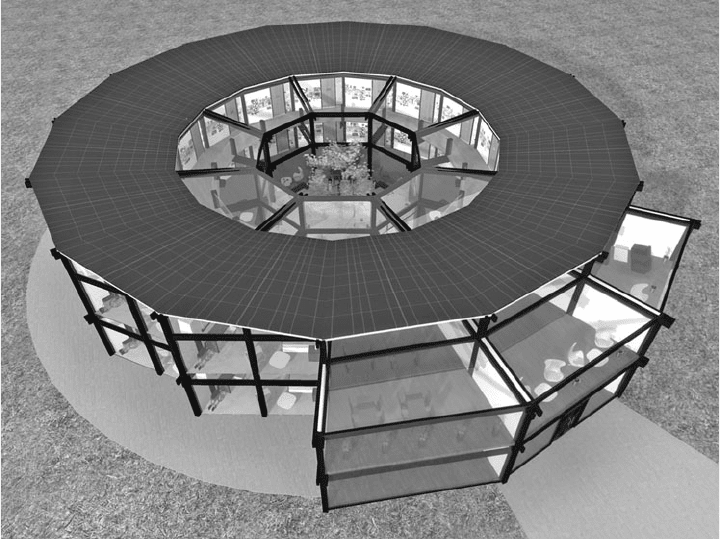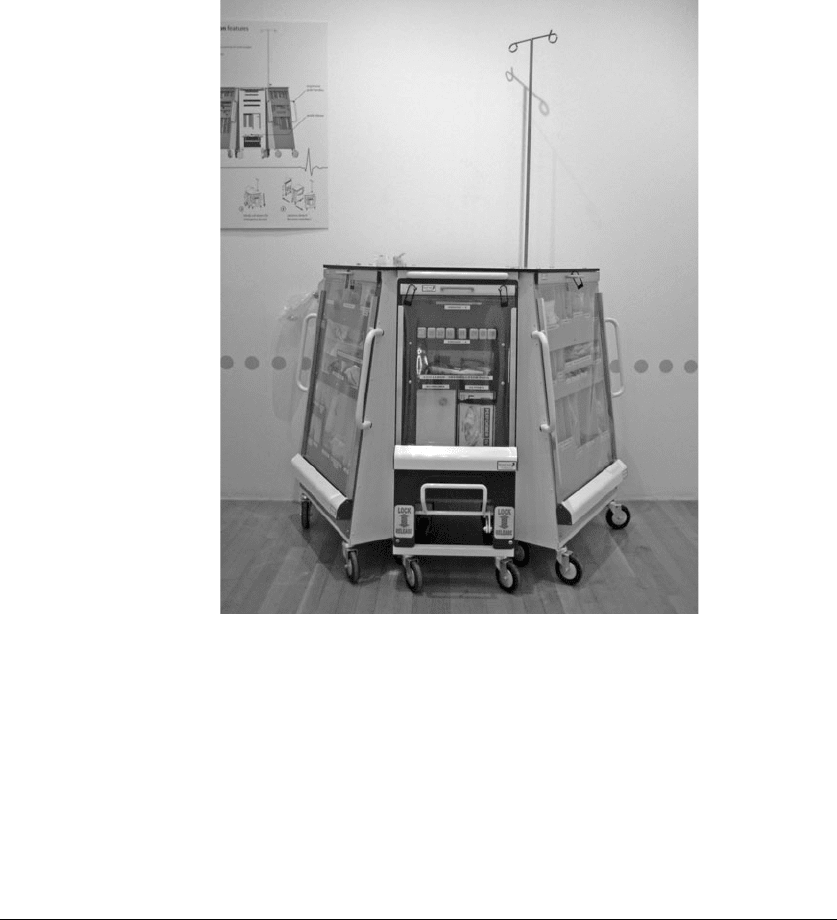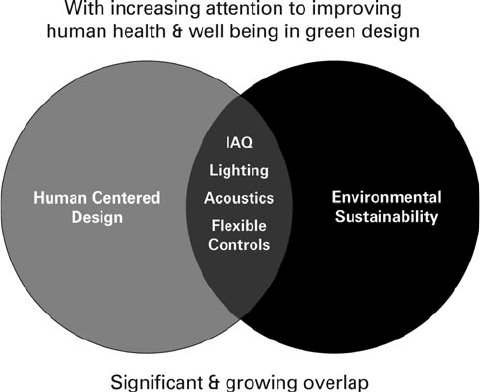Preiser W., Smith K.H. Universal Design Handbook
Подождите немного. Документ загружается.


36.10 EDUCATION AND RESEARCH
of the DBA Challenge, which it had entered twice. Sieberthead wanted the creativity, rapid
knowledge transfer, and teamwork processes to be condensed. The short workshop was a success,
and a series of Challenge workshops of different durations were subsequently devised and
delivered in the United Kingdom and overseas, including Norway, Singapore, Hong Kong, Japan,
and Israel.
Some Challenge workshops lasted just 24 or 48 hours; all made their mark on how partici-
pating designers think. Clive Grinyer, Director of Customer Experience at Cisco and keynote
speaker at the 2006 DBA Inclusive Design Challenge, described the impact: “It is the perfect
example of design thinking, building on new knowledge, placing designers in unfamiliar situ-
ations and forcing them to understand that the extremities of ability creates a powerful force
for innovation.”
Workshops explored new areas, such as design for dementia (DBA Inclusive Design
Challenge, 2008) (see Fig. 36.6), and living with rheumatoid arthritis (BMe Challenge Workshop,
March 2008, sponsored by Roche). The Challenge model also provided a platform for different
experts to work together. For instance, a workshop with the College of Occupational Therapists
in London (October 2007) brought together occupational therapists, designers, manufacturers,
and disabled consumers to explore the innovative possibilities of new materials in the design of
clothing for extreme needs.
36.8 CONCLUSION
In its design interactions with students, graduates, and professionals, the HHC’s research culture
has developed, over the past decade, a strong, practical linkage with industry. At each level of
FIGURE 36.5 Concept for the design of the future ambulance from the Smart Pods project
(2007–2009), which set out to rethink emergency mobile health care. Designer: Niki Merriman,
RCA Vehicle Design, www.smartpods.co.uk.
Long description: This computer-generated illustration shows a side view from the designer’s
perspective of the exterior of a mobile clinic that transforms from an ambulance. When the
ambulance stops, the back of the vehicle unfolds in the center and becomes a two-part “walk-in
clinic” with a central ramped entrance. The illustration shows this scenario.

INCLUSIVE DESIGN RESEARCH INITIATIVES AT THE ROYAL COLLEGE OF ART 36.11
experience, designers have exercised empathic skills as ethnographers and social researchers, as
well as expressing themselves as creative practitioners in a constant inquiry into the tools and
techniques required to transform practice and design. The HHC has also actively sought to com-
mercialize its research, regularly linking up with the college’s business network, InnovationRCA,
to effect real-world change.
Such an approach has given designers both inside and outside the college rich user experi-
ences, while introducing industry partners to a body of research about people-centered design.
Clearly, this strategy has owed more to the European tradition of inclusive design or design-for-
all, in which business opportunity is a key driver of change, than to the North American model
of universal design and its emphasis on social policy and legislative levers. These characteristics
illustrate the historical link between the contemporary Helen Hamlyn Centre and Agnew and
Archer’s pioneering National Health Service project to research a new standard hospital bed in the
late 1960s. Today, however, the center’s flagship NHS project is a redesign of the standard hospital
resuscitation trolley (see Fig. 36.7).
FIGURE 36.6 Modular care home design for people with dementia. Winning entry in the 2008 DBA Inclusive Design
Challenge. Design by Judge Gill.
Long description: This computer-generated image is an aerial view from the designer’s perspective of a modular care
home building based on a circular plan to ensure its residents never got lost and can be effectively monitored. Constructed
mainly from steel and glass that maximizes the available light, the building also has a central garden area that offers a
place to enjoy the changing seasons. The rooms with their floor-to-ceiling windows are angled from the central corridor
and look outward while the roof is composed of solar panels.

36.12 EDUCATION AND RESEARCH
36.9 BIBLIOGRAPHY
Blanchard, T., “The Style Council,” The Observer Magazine, Oct. 12, 2003.
Coleman, R., “The Case for Inclusive Design—An Overview,” in Proceedings of the 12th Triennial Congress,
International Ergonomics Association and the Human Factors Association, Canada, 1994.
Moggridge, B., i Magazine: Magazine for the Design Council, The UK Design Council, issue 6, 2001,
pp. 12–13.
Myerson, J., “Introduction,” in The International Design Yearbook 2001, M. de Lucchi (ed.), London: Laurence
King, 2001, pp. 6–7.
FIGURE 36.7 The hospital resuscitation trolley has been redesigned to
reduce medical errors. Designers are Sally Halls and Jonathan West. The trolley
is now in clinical trials in a U.K. hospital.
Long description: This photo shows the new design for a resuscitation trolley,
seen from the front, in a hospital corridor. Designers Sally Halls and Jonathan
West took this standard item of hospital equipment that is vital in emergencies
and redesigned it completely to help reduce medical error. Their modular ver-
sion splits into three parts so that defibrillators, drugs, and airway equipment
can be stored separately in a systematic way in three glass-fronted modules with
handles attached to the main body.

INCLUSIVE DESIGN RESEARCH INITIATIVES AT THE ROYAL COLLEGE OF ART 36.13
36.10 RESOURCES
British Standards Institution (BSI), BS 7000-6:2005 Design Management System, Managing Inclusive Design,
Guide, London, 2005.
Coleman, R., “Designing for Our Future Selves,” in Universal Design Handbook, 1st ed., W. Preiser and E.
Ostroff (eds.), New York: McGraw Hill, 2001, pp. 4.1–4.25.
Coleman, R., C. Lebbon, J. Clarkson, and S. Keates, “Introduction: From Margins to Mainstream,” in Inclusive
Design: Design for the Whole Population, London: Springer-Verlag, 2003.
www.designcouncil.org.uk/About-Design/Design-Techniques/Inclusive-design/.
www.designingwithpeople.org
www.education.edean.org.
www.inclusivedesigntoolkit.com
This page intentionally left blank

CHAPTER 37
AN INTERNATIONAL WEB-BASED
COLLECTION OF UNIVERSAL
DESIGN EXEMPLARS
Valerie Fletcher
37.1 INTRODUCTION
The international universal design movement has generated an expanding audience and with it, a
growing demand for information about practice and precedent. Today’s audience includes designers,
academics, clients, advocates, and policy makers in the developed nations and, increasingly, an
equally diverse audience in emerging nations. The literature of the field, however, is limited and
out of practical reach for many. Good educational content about universal design is available on the
World Wide Web, but specificity is lacking, the majority of the content focuses on private homes,
and much of the content is United States–centric.
There remains skepticism, especially among design practitioners and many design academics,
about whether inclusive design can be good design. It is a common concern about many value-
driven design movements. Other entities with different agendas are using the web to establish a
measure of good design that embeds a stated value—better public buildings by the Commission on
Architecture in the Built Environment in the United Kingdom, environmental sustainability by the
U.S. Environmental Protection Agency, or the multiple social and design values of the Aga Khan
Architectural Excellence Awards for buildings in nations with significant Islamic presence. A web-
based global collection of universally designed projects, which is the focus of this chapter, provides
a valuable understanding about current best practices as well as information about the design details
and process.
37.2 BACKGROUND
The Institute for Human-Centered Design (IHCD), formerly Adaptive Environments, witnessed this
rising demand for information directly in global forums. The organization hosted or cohosted five
international universal design conferences between 1998 and 2006. Those events offered an oppor-
tunity to bring leaders and acolytes of a burgeoning movement together and define the state of the
art at the time. With each event, expectations rose for content that was sufficiently robust to support
replication but that would also identify gaps and frontiers for the next chapter of exploration.
In addition to the episodic large events, increased demand for detail about real projects could
be measured in requests to IHCD from journalists, students, academics, design practitioners,
37.1

37.2 EDUCATION AND RESEARCH
consumers, and policy makers. The passage of the 2008 United Nations Treaty on the Human
Rights of People with Disabilities caused a surge in interest among governments and disabil-
ity activists in the developing nations newly aware of universal design and anxious to acquire
expertise.
Demand for substantive information was clearly a positive trend. A negative trend was also on the
rise that dismissed universal design as little more than a politically correct term for the familiar com-
pliance-based requirements of accessibility, more in line with the unavoidable fact of the plumbing
code. The field needed a refreshing resource of good design stories that would nourish the interested
and persuade the dismissive to reconsider.
The U.S. National Endowment for the Arts (NEA), through its 2008 Leadership in Universal
Design Award, recognized the need and provided initial funding to Adaptive Environments (renamed
the Institute for Human Centered Design in 2008) to create a web-based collection of case studies.
Each case study would include a narrative describing the project as well as photos, images, and
information about the process and the team that designed and built the project. The categories of the
built environment were health, outdoor places, transportation, commercial, culture, education, hous-
ing, public buildings, historic preservation, and religious spaces. Available anywhere anytime, the
web site would offer an efficient opportunity to grasp current practice, appreciate emerging trends,
and identify people and organizations doing the work.
37.3 DEFINING THE AUDIENCE: PERSONAS
All kinds of people in all kinds of places were looking for information not currently available. No
single resource would meet everyone’s needs and expectations. If the case study collection were to
be effective, a first task was to analyze the fit between IHCD’s strengths and the right subsets of
potential audiences. IHCD was used to creating “personas” as a discipline that is a defining tech-
nique of user-centered design, most often industrial or information design (see Mueller, 2004). The
content, look, and feel of the web site and programming decisions could only be made effectively if
the audience that was targeted was clear.
The project team narrowed an initial set of 18 categories of potential users down to 9. Aligning
organizational assets to unmet needs within the spectrum of potential audiences resulted in a focus
on universal design as good design. Nine named personas were created, each of which had a photo,
a role, a national and local identity, and a reason for the interest in universal design along with a
specific set of information needs. The user personas for the case study collection were as follows:
“Charlie”—an architect in San Francisco in the United States with a large architectural firm.
“Sangesh”— a mixed-use developer in Mumbai, India.
“Rebecca”—a community advocate in Toronto on the Development Committee for a new syna-
gogue.
“Roger”—a global nonprofit organization community planner in Nigeria charged with planning
for 10 new schools in the region with funding from the World Bank.
“Mary”— a professor of architecture in the United States at a prestigious university known for
its commitment to environmental sustainability.
“Haru”—a CEO of a mixed-use development firm in a midsize Japanese city.
“Melania”—an urban planner in Montevideo, Uruguay, overseeing a large transportation project
that will incorporate light rail and bus rapid transit.
“Hans”—an executive in a design-build firm in Germany with a contract to create an affordable,
green, and inclusive residential renovation of an historic factory building.
“Ahmed”—an architect and urban planner for Basrah, Iraq, leading the team to create a new
full-service hospital.

AN INTERNATIONAL WEB-BASED COLLECTION OF UNIVERSAL DESIGN EXEMPLARS 37.3
37.4 CASE STUDY TEAM
The organization’s team is a culturally diverse mix of designers, educators, and humanists aged 20 to
76. Salaried staff is supplemented by consulting project staff and by interns. International interns and
fellows expand both the linguistic capacity and the perspective of IHCD. The entire team comprises
approximately 40 percent people with disabilities.
The executive director wrote the proposal to the National Endowment for the Arts (NEA)
AccessAbility Leadership in Universal Design 2008 Award. The project director was the IHCD
Director of Design, Barbara Knecht, a registered architect and an architectural writer. As a student
at the University of California at Berkeley in the mid-1970s, she worked with Prof. Lifshez (1981)
and began a lifelong exploration with the power of design to minimize limitations.
Interns and IHCD consultants, e.g., a landscape architect, a cultural facility consultant, and a
senior educator/architect, supplemented internal staff. IHCD professional staff included three archi-
tects, an interior designer, an industrial designer, the director of a national housing project, and the
director of transit and urban projects. International colleagues assisted with translation and supple-
mented a limited use of paid professional translators.
Jury members were invited based upon deep expertise in at least one of the 10 categories of
the case studies, and they were chosen to ensure a mix of roles and a variety of global perspec-
tives. Fifteen jurors from eight nations agreed to serve. Jurors were asked to commit to a two-stage
process. In the first collection of case studies built with the NEA funds, the jury’s role was to
recommend potential projects and to review penultimate versions of the case studies. The jurors’
second-stage role was to review potential case study submittals for consideration after the initial
collection was open.
The project web site needed to reflect the same overarching commitment to universal design as
good design as the case studies. The web site had to be attractive to a design audience and usable
by anyone across a broad range of physical, sensory, and cognitive abilities. An extensive roster of
testers was engaged to review accessibility and usability.
37.5 GENERATING THE PROSPECT LIST
IHCD had an extensive global network and the collected experience of hundreds of workshops
and keynote presentations it sponsored or conducted. By the time of the NEA Universal Design
Leadership award in March of 2008, the definition of good design was being upended by the stark
realities of environmental degradation, profligate energy use, and global warming. Suddenly, an
aspiring environmental sustainability movement, fueled by a sense of urgency, seized the imagina-
tion of the design community as well as clients, policy makers, the media, and ordinary people. The
redefinition of good design was underway. No effort to promote design in relation to human diversity
could ignore it.
The sustainability transformation had its impact on universal design. Some leaders in the
movement in the European Union promoted inclusive design as a logical concept to integrate into
socially sustainable design. They pointed to new global policy definition of disability and health
as an opportunity to make universal design a linchpin of socially sustainable design. The World
Health Organization’s (WHO) 2001 publication of the International Classification of Functioning,
Disability and Health (ICF) mainstreamed functional limitation as a universal human experience and
went beyond previous policy to define disability as a contextual phenomenon subject to being exag-
gerated or minimized by the choices about the design of the environment. WHO policy called for
moving beyond the elimination of barriers to the development of environmental “facilitators” that
would enhance everyone’s experience (Walsh, 2001).
Universal design paired with environmentally sustainable design emerged in the 2004 conference
in Rio de Janeiro, including a keynote presentation by C. J. Walsh. The trend strengthened in the
2006 conference in Kyoto hosted by the International Association for Universal Design (IAUD) and

37.4 EDUCATION AND RESEARCH
included not only a rising emphasis on Eco-UD in product innovation but also in built environment
projects (see Figs. 37.1 and 37.2).
An open solicitation for case study submittals seems to be the most natural option for gathering
them. An open-ended call would harvest a large set of potential case studies from people around
the world who recognize the nomenclature of universal design, inclusive design, and design-for-all.
That would be an advantage and a problem. A quick volume of submittals would arrive, and they
would represent an easy-to-access sense of the field. Yet it would be only a slice of the quality of
work underway around the world. Many advocates of universal design have moved only incremen-
tally beyond the dominant concerns of accessibility and a focus on mobility, dexterity, and safety.
The challenge was to identify good inclusive design without assuming the designer or client overtly
framed universal design as a value.
With an open call, the majority of projects would be residential. It is simply the largest volume
of activity worldwide. Designing homes is also the most natural place to illustrate design that works
FIGURE 37.1 Panasonic Corporation’s Eco-UD model home opened to the
public in January 2006 in Tokyo.
Long description: Photo of the wide tile walkway over a shallow “moat” for
rainwater to the main entrance of the Eco-UD House. A long canopy extends
over a deck area along the entire side of the house. A glass entry includes auto-
matic sliding doors.

AN INTERNATIONAL WEB-BASED COLLECTION OF UNIVERSAL DESIGN EXEMPLARS 37.5
across the spectrum of ability and age. Fine residential work has been done around the world with
a large number of leaders in the field choosing housing design and construction as their primary
focus. Without duplicating effort, the challenge was to identify good residential design that illus-
trated new precedents for quality. The English-speaking world would likely predominate an open
call, because material about the call would be formatted in English. Although excellent projects
can be found throughout the English-speaking world, it would result in a distorted sense of the
state of the art.
IHCD chose a different and more deliberate route, with a great deal more work and higher level
of risk. The collection needed to convince skeptics by showing projects that stimulate a sense of
excitement and confidence that universal design is a fundamental aspect of design and not a periph-
eral set of ideas.
Having selected 10 types of environments—housing, health, outdoor places, transport, com-
mercial, education, housing, public buildings, historic preservation, and religious spaces—the team
broke the project into 10 categories and built a central database to manage potential candidates. The
project manager set up a server where all the digital files could be uploaded and available to the team.
The project director and executive director functioned as team leaders and set priorities based upon
meeting the needs of the perceived audiences. Priorities included these:
• Projects should be recently constructed or renovated, ideally within the last decade.
• Projects should demonstrate a starting point of basic accessibility but offer examples of
“facilitators” in line with the World Health Organization’s call in the 2001 International
Classification of Functioning, Disability and Health (see World Health Organization, 2002)
going beyond barrier-free design with features that enhanced experience for everyone.
• Projects should illustrate design features attentive to sensory, cognitive, mental health, and chronic
health conditions, such as breathing problems and chemical sensitivity.
• Projects should embody a commitment to good design.
FIGURE 37.2 Illustration with overlapping circles representing environmen-
tal sustainability and universal design.
Long description: The illustration depicts two circles, one for universal design
and one for environmental sustainability, with the overlapping area listing indoor
air quality (IAQ), lighting, acoustics, and flexible controls.
